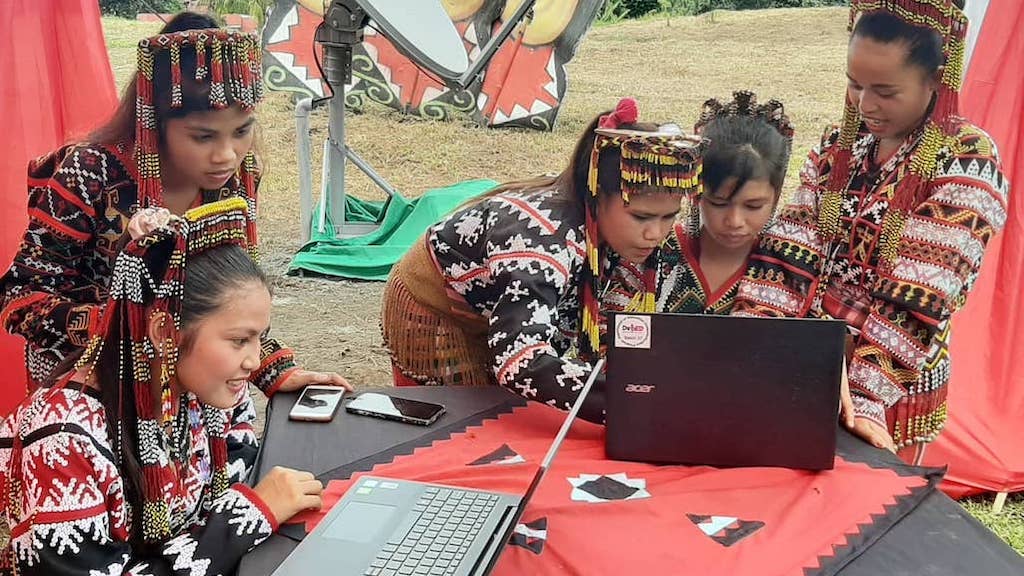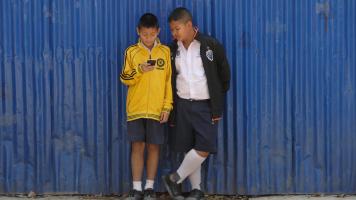
Students in Lake Sebu in South Cotabato in Mindanao surfing the internet using satellite connection. Phot credit: Ateneo de Davao University/Rogel Mari Sese.
Pilot project shows installation takes just half a day or a day at the most.
A university-led project to pilot satellite internet in remote areas in Mindanao is demonstrating that the technology can provide a quick solution to the connectivity problem in Southern Philippines.
The project, dubbed ACCESS Mindanao, is being piloted by the Ateneo de Davao University (ADDU). Since rolling out in December 2020, the project team has already installed satellite antennas in 11 of 12 target sites. ACCESS Mindanao is short for ADDU Community Connectivity Empowered by Satellite Services for Mindanao.
Rogel Mari Sese, program lead and chairperson of the university’s Department of Aerospace Engineering, said they were able to implement the program despite mobility restrictions to curb the spread of the coronavirus disease (COVID-19) in the region. The speed with which the project was carried out showed how fast satellite internet can be deployed in remote areas. He said. “It's something that can be done, and there's an efficient way of doing it. In 6 months, we've covered more or less all 12 sites.”
The sites are in various parts of Mindanao, including Davao Oriental, Davao de Oro, Bukidnon, Cotabato, South Cotabato, Maguindanao, Basilan, and Tawi-Tawi. The 12th satellite antenna was scheduled to be installed this month on Dinagat Island, which is on the northern tip of Mindanao.
Why access is crucial
According to the 2020 statistics from the International Telecommunications Union, only 43% of the population in the Philippines have internet access. The situation is much worse in Mindanao. Last year, a government official said only 20% of the Bangsamoro Autonomous Region in Muslim Mindanao has internet access. The region is among the poorest in the country, making it more vital to connect people to the internet, especially for education, as it is key to lifting them out of poverty.
Sese said ACCESS Mindanao aims to bring immediate community internet access—mainly for education, health, and social services—to remote and isolated communities using satellite technology.
The program showcases how space technology can connect remote and isolated areas without waiting months or even years before cell towers or fiber network infrastructure could be installed. “It’s really a rapid solution in remote areas where there is no connectivity.”
He said installing the project’s satellite antennas only takes half a day or a day at the most. “In just a day, we provide connectivity where no connectivity has existed before.”
The project demonstrates to government agencies and other institutions, and even the private sector, that space technology can provide an answer to the pressing need for internet connectivity, especially in Mindanao, he said.
Cost of implementation
ACCESS Mindanao budgeted 300,000 to 350,000 pesos ($14,800 to $17270) per site, depending on the location and the logistics of traveling to the sites. The budget covers the equipment, a year’s subscription to the service, and the maintenance and monitoring needed to ensure continuous service.
The project provides internet speed of 35 megabits per second (mbps) in all the sites. That is faster than the country’s average fixed broadband speed of 28.69 mbps reported by authorities in December. Based on the team’s tests, the service can support four to five simultaneous Zoom meetings using the same connection.
Sese said they piloted the project in 12 sites because of their limited budget, but if they get requests to provide the service and the interested party would shoulder the cost of setting up the system, they are willing to provide the service.
Since the Philippines does not have its own communications satellite in space, ACCESS Mindanao works with Singapore-based broadband satellite operator Kacific Broadband Satellites International Ltd. (Kacific) to get the satellite signal.
In 2019, Kacific launched a communications satellite, which is now providing high-speed and stable broadband internet access across Asia and the Pacific. The Asian Development Bank, together with development partners, provided $50 million for this satellite project.
The Philippine government has its own project providing satellite internet to remote communities. In March, the Department of Information and Communications Technology announced the rollout of free Wi-Fi sites and Very Small Aperture Terminal facilities in Sulu and Tawi-Tawi in the Bangsamoro Autonomous Region. The Wi-Fi hotspots were activated in Parang District Hospital and Mindanao State University in Sulu and in Bongao Municipal Town Hall, Tawi-Tawi Provincial Capitol, and Mindanao State University (Tawi-Tawi College of Technology and Oceanography) in Tawi-Tawi.
A catalyst for economic growth
Satellite internet is also being rolled out in other BIMP-EAGA countries. The ASEAN subregion considers digital connectivity among its development pillars because of its potential to spur trade and investment and empower individuals and societies to contribute better to the digital economy.
In Malaysia, satellite operator MEASAT Global Berhad recently started providing satellite broadband as part of plans to serve communities which cannot be reached via terrestrial communication infrastructure.
Indonesia started a project last year with private sector players to launch a communications satellite which could provide nationwide internet coverage.
Although internet coverage in Brunei Darussalam is close to 100% penetration, as early as 2018, telecom player Network Integrity Assurance Technologies still considers satellite internet as a viable option for people in remote areas in the sultanate.
This article was first published by BIMP-EAGA on 2 July 2021.

BIMP-EAGA
The Brunei Darussalam–Indonesia–Malaysia–Philippines East ASEAN Growth Area, or BIMP-EAGA, is a cooperation initiative established in 1994 to spur development in remote and less developed areas in the four participating Southeast Asian countries.


